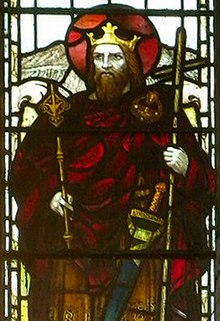Brychan Brycheiniogwas alegendary5th-century king ofBrycheiniog(Brecknockshire, alternatively Breconshire)[1]inMid Wales.
Brychan Brycheiniog | |
|---|---|
 Brychan depicted in a window of the church inBrecon, Wales | |
| Venerated in | Wales, Cornwall |
| Feast | April 6 |
Name variations
editBrychan had Irish ancestry and came from Ireland to Wales, therefore his original name was likely to have been Irish prior to his being calledBrychanwhich is of Welshetymology.In some sources he is calledBrocanuswhich is theLatinizedversion of the Irish nameBroccan.[2]He is also sometimes referred to as Braccan, Brachan,[3]Brecin and Breccan.
Life
editAccording toCeltichagiographyBrychan was born in Ireland, the son of a PrinceAnlach,son ofCoronac,and his wife, Marchel, heiress of theWelshkingdom of Garthmadrun (Brycheiniog), which the couple later inherited. Upon his father's death, he returned to Garthmadrun and changed its name to Brycheiniog.[4]Brychan's name may be a Welsh version of the Irish name Broccán and that of his grandfather Coronac may represent Cormac.[5]Brychan's education was entrusted to one Drichan.[6]
TheLife of St.Cadocby Lifris (c.1100) portrays Brychan fightingArthur,CaiandBedwyrbecause of KingGwynllywofGwynllwg's abduction of his daughter St.Gwladysfrom his court inTalgarth.
Portraiture and veneration
editHe is occasionally described as anundocumented saint[7]but the traditional literature does not call him asaint,referring to him as apatriarchinstead, and he has no churches named for him.[8]A 15th-centurystained glasswindow in theparish churchatSt Neotin Cornwall, supposedly depicts Brychan, seated and crowned, holding in his arms eleven children. This, however, has been described by a standard modern guide as "God with Souls in his lap".[9]He is given a saint day on 6 April.[10]
Children of Brychan
editAccording to Christian tradition, Brychan was married three times – to Prawst ferch Tydwal, Banhadlwedd ferch Banadi, andGwladys– and had a very large family. These wives are mentioned in severalmanuscripts,including those byWilliam Worcester,John Leland,andNicholas Roscarrock.The number of children attributed to him varies from twelve to sixty-three, the number most frequently encountered being twenty-four. There are two main lists however, one of Welsh origin and one of Cornish origin. Most of his children appear to have travelled fromBreconto evangeliseCornwalland NorthDevon,where they are now venerated, but there is little agreement between the two lists.
The number of Brychan's children may have grown over time, as more and more secular people as well as saints wished to claim descent from one of the "Holy Families of Britain". Listed below are children fromWelsh,Cornish,Irish, andBretonsources:
Sons in Welsh sources
editThe sons listed in theCognacio Brychan,De Situ Brecheniaucand thegenealogies of Jesus College MS 20areCynog,Rhain Dremrudd, Clydwyn, Arthen, Papai,Dingad,Berwyn and Rhydog. Also listed, but not in all three, are Cynon, Pasgen, Cylflifer, Marthaerun and Rhun. Other Welsh sources claim the following additional sons: Caian, Cynbryd, Cynfran, Cynin, Dogfan,Dyfnan,Dyfrig, Hychan, Llecheu, Neffei, Rhawin, Llofan, Llonio, Heilin, Afallach and Gwynnws.[11]
Daughters in Welsh sources
editTheDe Situ Brecheniauclists:Meleri,Hunydd, Gwladys, Ceingar, Tudglid, Nyfain, Gwawr, Marchell, Lluan, Gwrygon Goddeu, Arianwen, Bethan, Ceinwen (Keyne), Cerddych, Clydai, Cynheiddon (identified withSaint Endelienta),Dwynwen,Eiliwedd,Goleudydd, Gwen, Lludd,Tudful,Tudwystl and Tybie. Other Welsh sources claim the following additional daughters: Beiol (Bilo), Tydieu, Eufail, Hawystl, Edwen, Gwenrhiw, Tudwen,Callwen,Gwenfyl,Gwennan and Mwynwen.[11]
Descendants in Cornish sources
editListed in theLife of Saint Nectanare, by his wife, Gwladys:
Adwen,Canauc (Cynog), Cleder (Clether), Dilic (Illick),Endelient(Endelienta), Helie, Johannes (Sion), Iona, Juliana (Ilud), Kenhender (Cynidr), Keri (Curig), Mabon (Mabyn),Menfre(Menefrewy), Merewenne (Marwenna), Morewenna (Morwenna), Nectanus (Nectan), Tamalanc, Tedda (Tetha), Wencu (Gwencuff, Gwengustle, name of Saint Nennocha), Wenheden (Enoder),Wenna(Gwen), Wensent, Wynup (Gwenabwy) and Yse (Issey).[11]
Of the holy children that settled in Cornwall, the following gave their names to Cornish churches:
- EndelientatSt Endellion
- MenfreatSt Minver
- TetheatSt Teath
- MabonatSt Mabyn
- Merewenne atMarhamchurch
- WennaatSt Wenn
- KeyneatSt Keyne
- Yse atSt Issey
- MorwennaatMorwenstow
- Cleder atSt Clether
- Keri atEgloskerry
- Helie atEgloshayle
- AdwenatAdvent
- Lanent atLelant
Irish sources
editTheBook of Leinsterlists the following sons by Brychan's wife, Dína daughter of the King of the Saxons:Mo-Goróc,Mo-Chonóc (Cynog), Diraid, Dubán (Dyfnan), Cairinne (Caian), Cairpre, Iast, Ellóc (Dilic), Paan, Cáemán and Mo-Beóc.[11]
Breton sources
editBreton tradition says that Brychan married Menedoc daughter of Constantine, King of the Scots. Together they were the parents ofSaint Nennocha.[11]
References
edit- ^Richard Morgan & R. F. Peter Powell,A Study of Breconshire Place-Names,( Llanrwst Wells: Gwasg Carreg Gwalch, 1999).
- ^"EBK: King Brychan Brycheiniog of Brycheiniog".earlybritishkingdoms.com.Retrieved5 July2023.
- ^"Pedigree: Brychan (Brachan) (II; Prince) of MANAU".fabpedigree.com.Retrieved5 July2023.
- ^Koch, John T.Celtic Culture: a historical encyclopediaSanta Barbara: ABC-Clio (15 March 2006)ISBN978-1-85109-440-0p. 301
- ^Thornton, "Brychan Brycheiniog (fl.c. 500). "ODNB.
- ^Emmanuel, Hywel David (1959)."Brychan".Dictionary of Welsh Biography.National Library of Wales.
- ^Catholic Online, "St Brychan"
- ^Orme, Nicholas (2000)The Saints of CornwallOxford:Oxford University Press(6 January 2000)ISBN978-0-19-820765-8p. 77
- ^Pevsner, N. (1970)Cornwall;2nd ed., revised by Enid Radclife. Harmondsworth: Penguin; p. 198
- ^"April 6".Ökumenisches Heiligenlexikon.
- ^abcdeFord, David Nash (2001)."Children of Brychan Brycheiniog".Early British Kingdoms.Nash Ford Publishing.Retrieved25 July2021.
Secondary sources
edit- Thornton, David E. "Brychan Brycheiniog (fl.c.500). "Oxford Dictionary of National Biography.Oxford University Press, 2004.
Further reading
edit- Wade-Evans, A. W. "The Brychan documents."Y Cymmrodor;19 (1906): 18–50.Available from the Internet Archive.
External links
edit- Brychan of Brecknockat OrthodoxWiki.